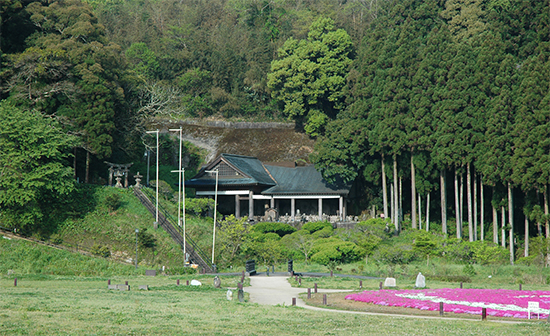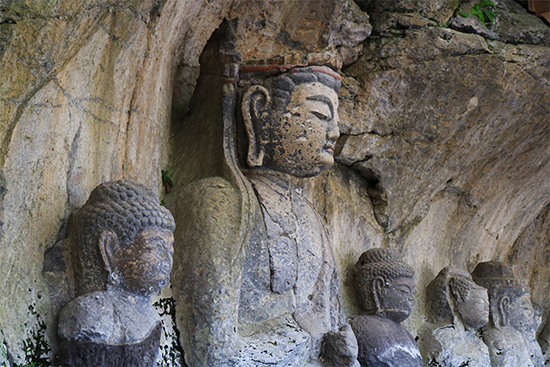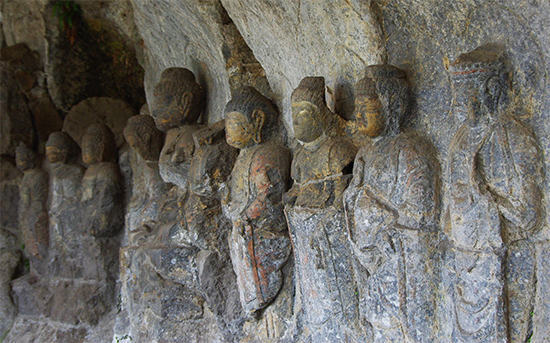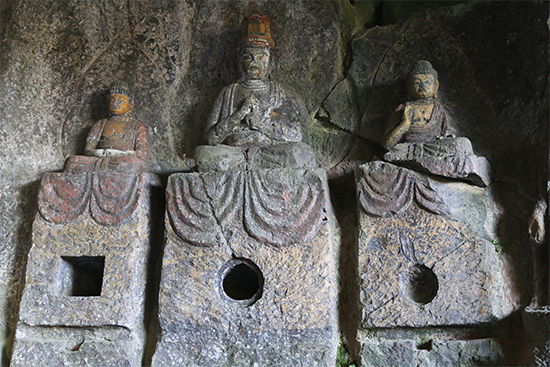 |
Focus features two in-depth reviews each month of fine art, architecture and design exhibitions and events at art museums, galleries and alternative spaces around Japan. The contributors are non-Japanese residents of Japan. |
|
|
 |
 |
 |
If Stones Could Talk: The Buddhas of Usuki
Susan Rogers Chikuba |
 |
Among the first statues encountered at the stone Buddha site is this trinity, often observed in the Pure Land Buddhist canon, with Mahasthamaprapta (the bodhisattva of strength) and Avalokiteshvara (the bodhisattva of mercy) flanking Amitabha, the savior Buddha. |
Last spring around the time of Vesak, an observance marking the birth, enlightenment and death of the historical Buddha Siddhartha Gautama, I found myself in the eastern Oita port city of Usuki, a place known for its dozens of ancient Buddha, bodhisattva, and deva figures carved from tuff-stone cliffs. Though it's uncertain who commissioned them from whom for what reasons, the 61 statues, each a designated National Treasure, are believed to date from around the early 12th to the 13th century.
Fast-forward a few hundred years, and the record of Usuki's rich history of cultural exchange is much clearer. As the capital of six Kyushu provinces, and a place readily accessible from Kyoto and Osaka when travelling by ship across the Inland Sea, the city flourished with domestic and international trade in the 16th century. William Adams, the first Englishman to set foot in Japan, alighted here. (Also known as Miura Anjin, he's a figure many Western readers will recall from James Clavell's semi-fictional account in Shogun.) Usuki Castle, parts of which still stand, was built by a man later remembered as the first Christian samurai. Today the old samurai residences, the Nioza historical district, and plentiful festivals from spring through fall are all attractive reasons to visit. But let's get back to the stone Buddhas.
 |
|
The six-hectare park lies in Fukata, a ten-minute taxi ride from Kami-Usuki Station. You can also rent bicycles at the Tourist Information Center in town and pedal there in 30 to 40 minutes, following the Usuki River upstream. |
The sekibutsu, as they are known, are tucked away in a sleepy rural hamlet that could be the backdrop to a Kurosawa or Ghibli flick, the statues providing plot leads and intrigue. There are long-necked ones thought to be in the style of a Korean guild of stone carvers, stout-necked ones believed to be the work of Chinese artists, and three that are said to have been done by amateur locals. (Various interpretive legends apply.) There's even a tale from our recent time, in the turbulent 1960s. Two years after the Usuki stone Buddhas came into the national limelight with their registration as Important Cultural Properties, the face of one -- Amoghasiddhi, the lord of karma -- was sliced off and carted away in the dark of night. A little over a month later it was returned, sent anonymously from a cargo address in Tokyo and wrapped in proper curatorial fashion for a national asset. One wonders if the perpetrator(s) knew what they were up against -- Amoghasiddhi is the wisdom Buddha who role-models our ability to turn the bitter energy of envy or jealousy into a positive force that benefits others. In any event, more than one face was saved in the caper: Amoghasiddhi bears a telltale scar but has since been restored. No investigation was ever launched.
 |
|
Mahavairocana, the Cosmic Buddha. This most famous of the Usuki statues has the large ears and small mouth (symbolizing compassion and discretion) and serene full face of the classic icon venerated for wisdom and truth. |
The carvings are found in four different clusters, each displaying works of a different period. Some historians equate these groupings with shifts in political relationships between this region and the national center over time. If you follow the loosely prescribed route you'll come to some of the oldest ones last, in the Furuzono section. Here, six bodhisattvas and devas flank either side of the Cosmic Buddha, the whole array believed to represent the metaphysical Diamond Realm mandala of Esoteric Buddhism. The most accomplished carvers of the time are thought to have been hired. Indeed, the centerpiece icon is regarded as one of the finest stone Buddhas in all of Japan.
 |
|
The Usuki sekibutsu are an international art collaboration, involving artists from China, Korea and Japan. Scholars say the carefully matched chin height of the 12 figures flanking the Cosmic Buddha is evidence that master carvers were at work. When moisture levels are just right, the faint remains of painted Sanskrit characters can be seen above a few of the figures. |
Several visitors in my group recalled having seen photographs of the Usuki Cosmic Buddha in their school textbooks, its huge noggin placed on the ground in front of it. Indeed it was only in 1993 that the head, believed to have fallen in some long-ago tremor, was reset on its shoulders. Back in 1955 the Buddha's left arm, surmised to have broken off when the head toppled onto it, was recovered. Discussions carried on about the best methods of repair and whether the statue should be made quakeproof -- work that would involve invasive drilling and steel poles. Eventually, true-to-weight models of the head were made and scores of simulations carried out. Extensive restoration was launched across the site between 1980 and 1993, when even the smallest fragments and chips were reattached to this and other statues.
 |
|
Good news if your visit falls on a rainy day -- the humidity will bring out, much more than is seen here, the scarlet, crimson, yellow, white and black natural pigments used by the original artists, as well as the colored mineral deposits within the stone itself. |
The preservation work continues, now primarily focused on stemming the speed of inevitable decay. Shinobu Yamaji directs the Institute for Conservation and Use of Cultural Heritage, Oita, an organization that employs infrared thermography, 3D imaging, and X-ray fluorescence to assess the condition of the statues. Its study of rain, wind, humidity and other climate conditions at the site informed the construction of wooden awnings and open shelters two years ago. Now Yamaji oversees a maintenance project that uses UVC, a non-thermal form of ultraviolet irradiation, to staunch the growth of microorganisms on the statues' surfaces and clear any mosses, lichens and blue-green algae that can't be brushed off or tweezed out. After cleaning, a proprietary silicon-based water repellent is applied to ward against further vegetative growth.
When I first heard of that measure I couldn't help but wonder if coating a spiritual icon with silicon isn't something like botoxing a goddess. Does the thwarting of natural processes like plant growth and stone erosion jibe with the dharma of cyclical birth, death and rebirth? Or, since questioning and curiosity are our human ticket to liberation, is conservation for the benefit of future generations rather a response to the Buddha's appeal that we be true to the best in ourselves? Later, Yamaji assured me of her faith in the latter: "The statues are very much alive," she said. "They're exposed to the elements and much about them changes from season to season, even from one weather pattern to the next. A lot of their appeal lies precisely in the fact that they're not behind museum doors." Decisions about conservation are based on painstaking study, and bring together not only scholars and historians, she explained, but also city officials, local residents and volunteer guides in a shared sense of community.
 |
|
Openings in the base of statues like these are believed to have been where devotees inserted written prayers or votive sutras. The groove cut into the base of this group suggests that a wooden platform once rested here, on which people sat to pray. |
One prevailing theory about how the sekibutsu came to be concerns the Oga family, which rose to power in the vicinity partly through its affiliation with the influential Fujiwara clan in Kyoto. The Fujiwara were regents to the imperial court and kept a manor home in Usuki, likely managed on their behalf by this family and its offshoots. Thanks to this connection, the theory goes, the family had the means to hire the best masons from Nara and Kyoto and even beyond Japan's shores. Also, Pure Land piety was well established by the 11th century and was especially in vogue in the 12th. Whoever commissioned the statues must have been an avid believer in the tradition's prayers for enlightenment and rebirth in paradise, and its teaching that Amitabha and attendant bodhisattvas will escort the faithful there upon death. By this thinking the sekibutsu are the product of fervent devotional practice, made possible through the patronage of the Fujiwara. It's true, too, that the period of their creation was a time of great power shifts, as the imperial court gave way to the rise of the military class. In troubled times the stone Buddhas of Usuki were a refuge, a place to pray for ongoing life in this world or the next.
 |
|
The cluster known as Hoki I displays more than 20 statues in its four chambers. Pictured here is the bodhisattva Jizo seated in half-lotus position with ten kings. |
For modern-day sojourners and aspiring bodhisattvas carrying on in a time when there's still no shortage of political conflicts or greed, hate and ignorance, a visit to Usuki and its statues remains an opportunity to reflect on Siddhartha's teachings. Though first offered some 25 centuries ago, those insights on peace, service and shared humanity are just as fresh today.
Timeworn gorinto, or five-tiered stupas, line a path between the open-air galleries. Their parts from the bottom up represent earth, water, fire, air and energy, but in esoteric practice signify also the path of learning -- the square base being the will to attain perfection; the circle, equanimity; the triangle, energy created in the pursuit of truth; the crescent, honing of intuition and awareness; and the crowning jewel, perfection. |
The sekibutsu are viewable year-round. If you're planning a trip to Usuki, calendar highlights at the site include the New Year's Eve Buddhist service held by candlelight, the phlox and cherry-blossom seasons from mid-March to mid-April, the Lotus Festival held from mid-July to early August, and a fire ceremony held on the final Saturday of August. Cosmos bloom from late September to October. This year, 20,000 spider lilies were planted on-site, an attraction that promises to become an annual autumn highlight. English-speaking volunteer guides are available by appointment for a one-hour tour of the statues free of charge; call the park office at 0972-65-3300 to arrange.
Cosmos flowers, associated with ideas of balance, tranquility, pureness and peace, bloom at the Usuki site in early autumn. |
All images are courtesy of Usuki City. |
 |
 |
Susan Rogers Chikuba
Susan Rogers Chikuba, a Tokyo-based writer, editor and translator, has been following popular culture, architecture and design in Japan for three decades. She covers the country's travel, art, literary and culinary scenes for domestic and international publications. |
|
 |
|